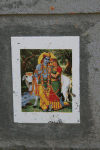
Lord Krishna, and his consort Radha, on a temple in Dhulikhel, Nepal. (947k)
Vishnu is the Protector. He was alone there in the beginning. From his navel grew a lotus, which brought forth Brahma, the Creator. Vishnu is part of the Trimurti, the Divine Trinity, the other two being Shiva and Brahma.
Vishnu's consort is Lakshmi, the Goddess of Wealth. He is the brother of Parvati, the consort of Shiva.
His eternal or permanent abode beyond the material universe is Vaikuntha which is a realm of eternal bliss and happiness. It is also known as Paramdhama, which means final or highest place for liberated souls, where they enjoy eternal bliss and happiness. Vaikuntha is situated beyond the material universe and hence, can not be perceived or measured by material science and logic.
His other abode within the material universe is Ksheera Sagara, where he reclines and rests on Shesha. It is known to be the topmost realm in the material universe, even higher than Satyaloka where Brahma resides. Vishnu manages and sustains the universe from there.
Shesha is the king of all nagas (cobras), one of the primal beings of creation, and an Avatar of the Supreme God known as Narayana. Shesha is said to hold all the planets of the Universe on his hoods and to constantly sing the glories of Vishnu from all his mouths.
Vishnu's symbols are the Padma (lotus flower), the Gada (mace), the Shanka (conch shell) and the Chakra (a spinning disk weapon).
Vishnu is usually colored blue and clothed in yellow. One of his depictions is standing upright on a lotus flower. He has four arms, holding his four symbols, the Padma, the Gada, the Shanka, and the Chakra.
His other depiction is reclining and resting on Shesha, with Lakshmi at his feet.
Vishnu's vehicle is Garuda, a combination of man and eagle. He is often depicted as riding on his shoulders. In front of most Vishnu temples is a statue of Garuda, usually a human figure with eagle wings.
Vishnu has ten incarnations.
The first incarnation was Matsya. In this incarnation he had the lower body of a fish, and the upper part of a man with four arms. One legend says that Vishnu turned into a fish so he could tow the ship on which Manu, the progenitor of the human race, had taken refuge from a great flood.
The second incarnation of Vishnu is Kurma. He is half man, half tortoise, with four arms. When the Gods were in danger of losing their authority over the demons, Vishnu advised them to churn the ocean so that they might get amrita (ambrosia), which would make them strong and immortal. He promised to become a tortoise on which would rest the mountain Mandara, which was used as a churning stick.
The third incarnation of Vishnu is Varaha (the boar). When earth had been abducted by a demon and hidden at the bottom of the ocean, Vishnu turned himself into a boar to rescue earth. After a long struggle, Varaha slew the demon, rescued earth, and brought it to the surface. He made it ready to support life by modeling the mountains and forming the continents. In this way the earth was brought into being again to begin another kalpa (cycle).
His fourth incarnation is Narasimha, half man half lion, with four hands. Vishnu assumed this form in order to overcome a demon king, who could not be slain by man nor by beast, neither inside the palace nor outside, neither by day nor by night. Vishnu, in the incarnation of Narasimha, approached the palace by dusk, and hid in the pillar at the entrance. When the demon king approached, he killed him on the threshold of the palace at dusk, as a creature half beast, half man.
In the first four incarnations Vishnu appeared as either an animal, or half beast, half man. The fifth and all subsequent incarnations are in full human form.
The fifth incarnation is Vamana, the dwarf. Legend says that Bali, the great-grandson of Hiranayakashipu was a very successful ruler. His reputation started to overshadow that of Indra, who asked Vishnu's help in order to regain his supremacy. Since Bali was such a praiseworthy ruler, Vishnu did not want to use harsh measures. He disguised himself as a dwarf, and asked Bali to give him a piece of land three paces wide on which he could sit and meditate. When Bali granted the request, Vishnu used his supernatural powers to take possession of heaven and earth in two paces, thus depriving Bali of his kingdom. But because of Bali's generosity Vishnu did not take the third step to take possession of the netherworld as well, but installed Bali as its monarch. The story of Vishnu's dwarf is a creation myth symbolizing the power of Vishnu to cover the universe.
The sixth incarnation is Parashurama. He has four hands, carrying a battle ax, a sword, a bow and an arrow. Legend says that a Kshatriya king had stolen Parashurama's father's wish granting cow, Kamadhenu. Parashurama took revenge by killing the thousand-armed king. In retaliation, the king's sons killed Parashurama's father. Vishnu took the form of Parashurama to get revenge and to rid the world of the oppression by the Kshatriya kings, which he did in twenty-one battles.
Rama, the seventh incarnation is usually shown standing with two arms, one of them holding a bow. His consort in this incarnation is Sita. Hanuman, the Monkey God, is a devotee of Rama, and is often shown kneeling in front of Rama. Rama's task was to kill the ten-headed demon Ravana, who held his wife captive.
Krishna, the eighth incarnation, is considered the most important incarnation of Vishnu. Krishna is usually blue, having two hands, playing a flute. He was born as a cow herder, so he is often shown with one or more cows. His consort in this incarnation is Radha. Vishnu manifested himself as Krishna to kill the evil king Kansa. The king had been forewarned that the eighth child of Devaki would kill him, so he imprisoned Devaki and killed all the new born babies, one by one. The seventh child, Balarama was saved by his kinsmen. When the eighth child was born, there was a big storm, the doors burst open, and the guards fell asleep. Vasudeva, Krishna's father walked out of the prison, taking the baby Krishna with him to Yashoda, where Krishna spent his childhood, to later kill the king Kansa.
The ninth incarnation of Vishnu is Buddha. He appears at the start of the present age. This incarnation reflects the intellectual and scientific development of mankind. This ties Buddhism into Hinduism.
The tenth, future, and last incarnation of Vishnu is Kalki. It will appear at the end of the present age, when moral excellence no longer exists, the rule of law disappears, and all would be darkness. Kalki would then ride forth on a horse, blazing like a comet, and save mankind, and re-establish Dharma (Righteousness). Kalki would usher in the Golden Age, a new era of purity and peace, and then return to heaven.
You can find more information on the Vishnu page on Wikipedia.
Much of the information on this page comes from "Hinduism An Introduction", by Dharam Vir Singh, Travel Wheels, Jaipur.
All pictures are © Dr. Günther Eichhorn, unless otherwise noted.

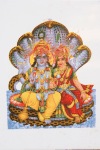
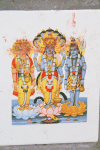
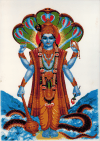
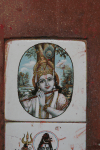
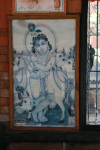
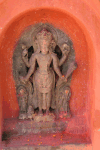
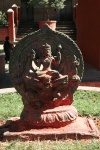
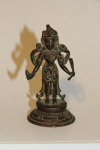
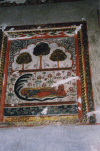


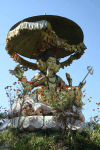
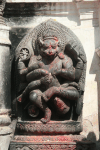
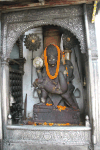
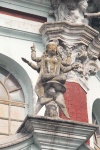
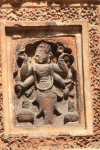
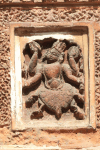
Vishnu's vehicle is Garuda, a combination of man and eagle. He is often depicted as riding on his shoulders. In front of most Vishnu temples is a statue of Garuda, usually a human figure with eagle wings.
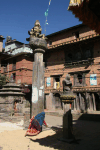
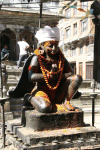
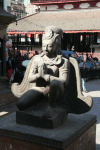
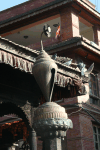

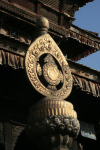


This page contains 23 pictures
Page last updated on Thu Dec 31 15:01:26 2020 (Mountain Standard Time)
Hindu God Vishnu on soaring.guenther-eichhorn.com